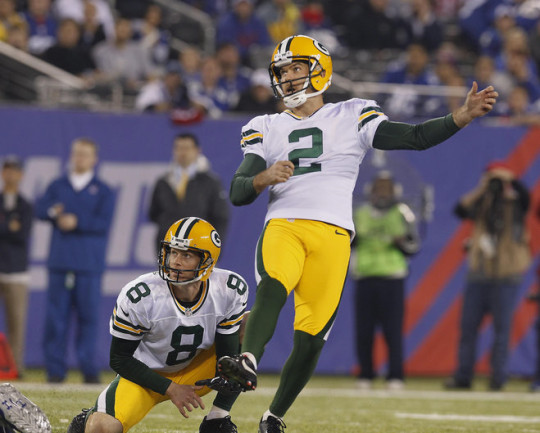After the NFL announced changes to the rules regarding PATs, the Green Bay Packers, like the rest of the league, will have to develop new strategies on what they should do after scoring a touchdown.
Kicking an extra point has almost always been what teams choose to do. In 2014, there were 1230 attempted extra points, as opposed to just 59 two-point conversions. When kickers were making extra points with a 99 percent success rate, the decision was never that hard to make.
But now, coaches will have a slightly more difficult time choosing whether or not to go for two. Extra points will now be 33 yards long. Over the last ten seasons, that field goal has been converted just under 92 percent of the time.
Packers kicker Mason Crosby is the obvious answer for the Green Bay player who will be most affected by the rule change. Over the course of his eight-year career, Crosby has converted 99 percent of his extra point attempts, missing just four. But when a field goal is between 30 and 39 yards, his career average is at just 87 percent.
While that number does not completely reflect how Crosby will fare with the new PATs (as some of his misses came from 34-39 yards, which is further than the new extra point), it is reasonable to expect that he will miss more PATs than in the past. The five blocked kicks in 2014, including two blocked extra points, could also be concerning if the Packers do not address that issue in the upcoming season.
The Packers’ coaching staff will now also have to decide when to go for two. The Packers attempted just three two-point conversions in 2014, and it is likely that that number will increase, if only slightly. That is because two-point conversions now produce more “expected points” per attempt than kicking an extra point.
League-wide, going for two has been successful roughly 47 percent of the time over the past ten years. That means that the “expected points” per two-point attempt are .94. Thirty-three yard field goals, which are made just over 91 percent of the time, produce .91 expected points per attempt.
But while the league average seems to justify going for two more often, the Packers may continue to steer clear of it. Over the past five years, Green Bay has converted just two out of 11 two-point conversions (18 percent), a percentage that is far below that league average. Based on that success rate, Green Bay’s expected points would be just .36 per attempt.
Statistically, the Packers are better off continuing to just kick the extra point. And while the Packers may work on drawing up new plays to increase success at going for two, Green Bay’s offense will probably be only marginally affected by the new rule change.
However, the Green Bay defense will also have to adapt to the possibility of more teams going for two. Since the 2010 season, opponents have converted eight out of 17 times for a 47 percent success rate. It is highly unlikely that teams will go for two every time they score, but the Packers have to be ready for a probable increase in the number of conversions they have to defend.
There are a number of other factors that Green Bay will have to consider on both the offensive and defensive side of the ball during PATs. The Packers had issues with blocked field goals and extra points last season, which could now result in points for the opponent if it happens again this year.
Intangible elements such as pressure will also be more prevalent. Crosby has, for the most part, been a clutch kicker for the Packers. But there is still an added element of pressure for Crosby knowing that extra points are no longer as automatic as they once were.
The change in extra point rules will not have a drastic effect on Crosby or the Packers in general. Occasionally, decision-making will be different than it was a year ago. For the most part, Packer fans can expect to see Crosby heading onto the field after every touchdown and connecting from 33 yards out for the extra point.
——————Sean Blashe is a Packers fan who grew up in Bears territory and is currently a journalism and history major at Marquette University. Sean is a writer with PackersTalk.com and you can follow him on twitter at @SeanBlashe .
——————

